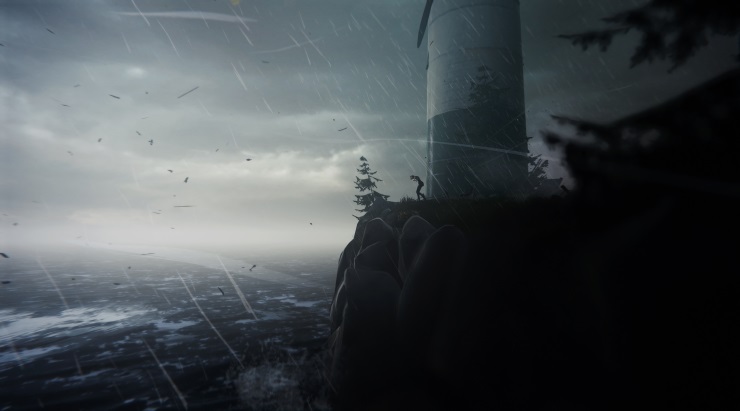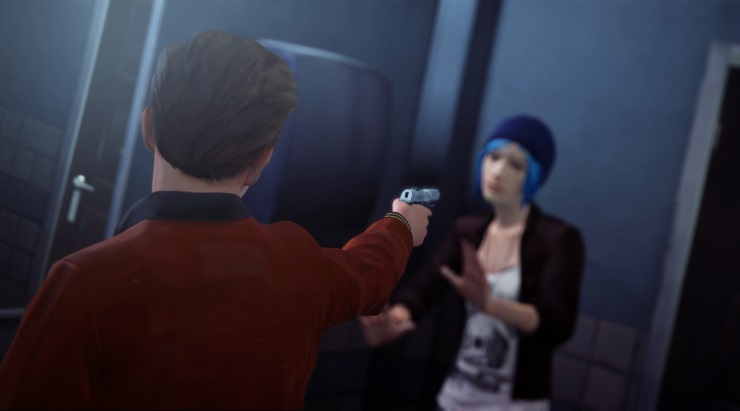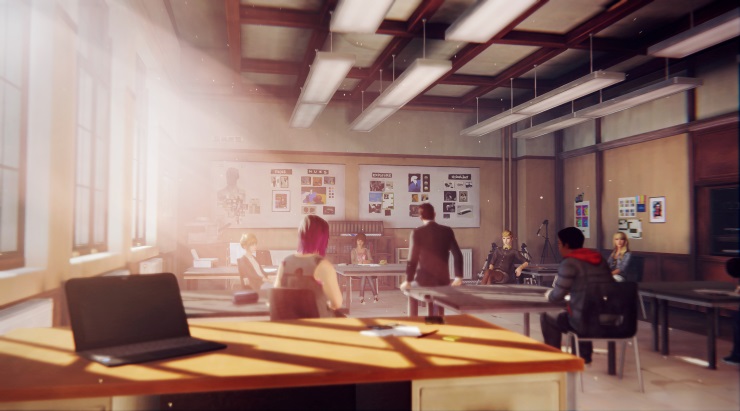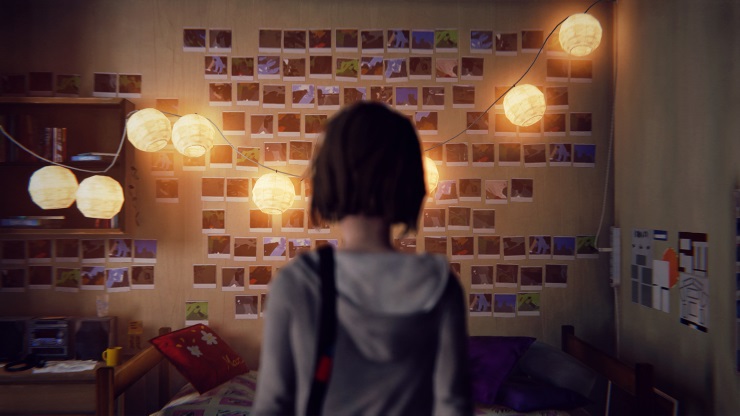There are some announcements in games that get you instantly excited, such as DICE teasing a new Star Wars Battlefront, Miyamoto announcing Twilight Princess or that first look at the PS2. Then there are others that, while they sound intriguing, don’t quite generate the same kind of excitement. For me, the announcement of Life is Strange fell into the latter camp, but oh how my opinion has changed since playing it, and talking to the game’s Creative Director.
Dontnod’s debut title was Remember Me, a third person action adventure title, while Life is Strange is an episodic adventure game. Despite the significant shift in genre, however, Creative Director Jean-Maxime Moris thinks there is a lot of similarities between the two.
“I actually think there is a lot of Remember Me in Life is Strange. There was one thing that carried over from Remember Me and it’s a huge thing because it’s the core of this game, I mean mechanic-wise, which is the rewind.”
Max, Life is Strange’s protagonist, discovers early on that she has the ability to rewind time and relive that moment again. A similar mechanic was implemented in the memories of Remember Me, and it allows Max to use the experience she has the first time round to correct any mistakes in the second or third time of re-living that moment.

“We are also looking at a human identity again but from a different perspective, it’s not digitised memories any more, it’s these analogue pictures that Max takes and lays on the floor and those choices that she makes that will determine who she becomes. The story could have lent itself to a movie as well but its great with all these characters to really develop their relationships over the course of different episodes.”
“It’s built in Unreal Engine 3 which we used to develop Remember Me. It has all the tweaks and the additions that we developed in house for Remember Me, especially in terms of lighting, rendering and particles, which means that this is basically Unreal 3.5. It’s Remember Me’s engine at its best. That’s the reason why it was really easy to go into this game and develop it cross platform because we didn’t have to worry about the tech and could focus on developing the content and then just port it onto other platforms.”
While there may be more than a few similarities between the two games, Jean is keen to stress that the move to an episodic format – one of the most obvious differences between the titles – happened organically.
“It was really something that happened very naturally when we were thinking about what it was that we were going to do. We were sitting in a room and someone asked ‘Why not do it episodic?’ We looked at each other – and we are obviously all huge fans of the TellTale games and of TV series – and we thought ‘Lets try it’. It’s that simple really. Then of course we did our homework and looked at how the other guys had done it, the TellTale guys for instance. I think it’s great to be able to face that challenge as a studio, of hooking the player early, developing stories that foster a sense of closure in one episode but hook you into the next. When you play Episode 2 having all your choices factor back into what it is that you are playing six weeks after you played it, it’s very interesting creatively just to be working along those lines. It’s very different from what we were doing before.”

The episodic format isn’t just new for Dontnod, it is also Square Enix’s first ever episodic game. With TellTale doing so well with their efforts it is understandable why Square wanted to get in on the fun, but it is still a big risk for the publisher.
“Square Enix started to discuss the game with us and they were totally on board with the episodic format, so we quickly realised that there was a match between what we wanted to do and what a publisher would want us to do. As a studio we talk to all publishers all the time. Every time we have a new concept or a new idea we talk to everyone. Of course if we can foster a long-term relationship with a given publisher then all the better. We had tired to partner with Square on Remember Me, but it didn’t happen. This time we basically talked to everyone and they were the only ones that didn’t want to change a thing.”
One of the more talked about areas of Life is Strange pre-launch is the two main female characters, and the distinct lack of a male protagonist. J-Max has previously stated that many of the other publishers Dontnod spoke to wanted to change Life is Strange significantly, mainly to bring in a male lead character.

“I think a lot of the thinking that happens in the industry right now is still based on cliché that was inherited from the 90’s, where only 15 year old boys who wanted hyper sexualised female characters or to be bad asses and those big guys going into war played games. I think those people have grown up, and many more people are flying into the industry than ever before. Publishers think it’s not going to work because it has a female character, so they wont invest into the marketing of this game. Then it doesn’t work – because there is no marketing – but the blame lands on the game having a female lead character, and the cycle goes on and on and on. It’s thanks to people like Square on this one or Capcom on Remember Me that things can change.”
Even with Capcom and Square taking a chance with Dontnod’s lead female characters there is still the perception that lead female characters aren’t a strong selling point. Only games like Life is Strange can hope to change this, but that wasn’t the key message the developers set out with.
“It takes time to change mentalities. This particular gender thing in video games is part of a much bigger social and political issue, which is gender equality, and I have no idea. If it can change one person’s mind then I’ll consider it a success.
Just to be clear though, this is not what we set out to create this game for. This is not a political game, it just happens that there are female lead characters and I happen to have a opinion as a individual, and if this can change another individuals opinion then I am happy. As a creator though, if a female character is bad then I’ll say it’s a bad character but I won’t mention the gender. I don’t think that’s a useful distinction.”

While Life is Strange is a story based game, it does contain some puzzle sections. Jean denies that they will overpower the other elements within the game.
“Life is Strange is definitely not a puzzle game, instead it emphasises the story, your choices and the characters. There are some puzzle sections though and they will grow more complex throughout the game. My favourite ones are the ones that involve talking to people, learning something about them and then convincing them, manipulating them, and you know you can combine that with the more space orientated ones.”
Another noticeable quirk of Life is Strange is the butterfly symbol that frequently appears in the top left corner of the screen whenever you make a choice, in a similar style to TellTale’s They Will Remember That message. However, sometimes the symbol appears in situations that seem very inconsequential. J-Max assures me that every decision is important.
“It has been a very long discussion internally because other games, they tell you X number of things might have consequences but then only a fraction of them do. We decided to have every single thing that says it will have consequences have them. Some will have major consequences further down the line if combined with other things or minor consequences in themselves. Others will have just short-term consequence that you can see in a cut scene three minutes later, but they will all have a consequence.”

With all the choices you make having some kind of consequence, one would assume that the overall series will feature multiple endings, based on the more significant choices you make.
“There is no way a small to medium sized company can afford to have a story that branches into a hundred different directions because it costs so much money in terms of animation, recordings, polishing, maintenance, QA, modelling, everything that happens in the production cycle would cost just too much. So the way we are tackling this is by saying that the game will move forward in the overall same main direction for everyone but it is the choices that you make that will tailor the experience to you.”
“With all the decisions that you make, there will be more than one ending but there wont be 67 and its generally going to be in the spirit of TellTale games, I’m not going to set false expectations here. But even in the case of Telltale, what’s really great is that it’s the details and the different ways that people are going to interact with you and talk with you that’s going to make that experience different, even if the ending remains the same. One of the best endings to a game was the close of TellTale’s The Walking Dead Season One, and it would have been a shame to have 90% of players miss it because only 10% made the choices that led to that ending.”
Having the characters interact with Max in different ways was certainly noticeable during my time with the game, thanks to replaying certain situations with the rewind feature and seeing the different reactions from people. It is worth saying that the characters themselves are so far so good, mainly thanks to the incredible voice actors that are on board.

“We chose to not go for Hollywood talent that we could stick on the screen and say ‘oh it has this famous actor.’ Instead we chose to remain in the independent spirit and so all our actors are fairly independent in terms of the movies they play in, although we do have Ashly Burch who is playing Chloe, who you might know Borderlands 2 or her Hey Ash Whatcha Playin videos.”
Episode One of Life is Strange is almost upon us, but that doesn’t mean the studio is easing up…
“Our goal is to have a steady time window in between releases. That is very important to us but that means we had to plan a lot ahead and all the episodes are being worked on in parallel, so Episode One right now is in polish phase and basically finished. Episode Five is already being worked on. What we would like to do, because episodic game communities are very vocal, is to take feedback from the community into account. It’s not going to be possible for Episode Two for instance, and we need to make decisions and we can’t listen to everyone, but some of that feedback you might see factor into later episodes of the series and a second series, if there is one.”
Now when you interview a developer, and they mention the possibility of a sequel to their upcoming game, you just can’t pass up the chance to ask them if they are already at work on a sequel.

“Of course. Will I talk about it? NO! I mean we are at this stage where it’s the conception phase, so we don’t know what we want to do but we have started to bounce ideas around about what it’s going to be. Any type of company relies on it successes to move forward, so we want Life is Strange to be a success. If it is not, it’s going to put us in a difficult position. We are also as a company thinking forward, we are thinking of the future of the Life is Strange brand and we also have a few other ideas brewing that we are talking to publishers about. A lot will depend on Life is Strange but we want to have a plan B as well.”
“The vision of the studio is to try at least to do things different, although we obviously want to capitalise on everything that we create, whenever we can we try to do something that’s different and this time it’s this type of game. It might be something different in the future.”
Life is Strange is really shaping up to be something special. It has some unique ideas, with an intriguing story and some brilliant characters, but the real question is where does Jean-Maxime Moris, Creative Director at DONTNOD Entertainment keep his ketchup?
“It’s in the cupboard. Yeah in the cupboard with all the mustard and everything. If someone puts it back in the fridge I take it out, the same with honey and jams. And to be very specific it’s a shelf, it doesn’t have closing doors and is really open to the air around it.”
Thanks to J-Max for his time.





